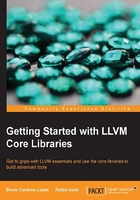
Conventions
In this book, you will find a number of styles of text that distinguish between different kinds of information. Here are some examples of these styles, and an explanation of their meaning.
Code words in text, database table names, folder names, filenames, file extensions, pathnames, dummy URLs, user input, and Twitter handles are shown as follows: "The prebuilt package for Windows comes with an easy-to-use installer that unpacks the LLVM tree structure in a subfolder of your Program Files folder."
A block of code is set as follows:
#include <stdio.h>
#include <stdint.h>
#include <stdlib.h>
int main() {
uint64_t a = 0ULL, b = 0ULL;
scanf ("%lld %lld", &a, &b);
printf ("64-bit division is %lld\n", a / b);
return EXIT_SUCCESS;
}
When we wish to draw your attention to a particular part of a code block, the relevant lines or items are set in bold:
KEYWORD(float , KEYALL)
KEYWORD(goto , KEYALL)
KEYWORD(inline , KEYC99|KEYCXX|KEYGNU)
KEYWORD(int , KEYALL)
KEYWORD(return , KEYALL)
KEYWORD(short , KEYALL)
KEYWORD(while , KEYALL)
Any command-line input or output is written as follows:
$ sudo mv clang+llvm-3.4-x86_64-linux-gnu-ubuntu-13.10 llvm-3.4 $ export PATH="$PATH:/usr/local/llvm-3.4/bin"
New terms and important words are shown in bold. Words that you see on the screen, in menus or dialog boxes for example, appear in the text like this: "During installation, make sure to check the Add CMake to the system PATH for all users option."
Note
Warnings or important notes appear in a box like this.
Tip
Tips and tricks appear like this.